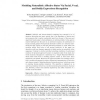62 search results - page 11 / 13 » A Salience-Driven Approach to Speech Recognition for Human-R... |
ATAL
2007
Springer
14 years 1 months ago
2007
Springer
A robot’s ability to assist humans in a variety of tasks, e.g. in search and rescue or in a household, heavily depends on the robot’s reliable recognition of the objects in th...
AIHC
2007
Springer
14 years 1 months ago
2007
Springer
Affective and human-centered computing have attracted a lot of attention during the past years, mainly due to the abundance of devices and environments able to exploit multimodal i...
JAIR
2010
13 years 6 months ago
2010
To tackle the vocabulary problem in conversational systems, previous work has applied unsupervised learning approaches on co-occurring speech and eye gaze during interaction to au...
HCI
2009
13 years 5 months ago
2009
This paper presents a system for another input modality in a multimodal human-machine interaction scenario. In addition to other common input modalities, e.g. speech, we extract he...
ICMI
2004
Springer
14 years 27 days ago
2004
Springer
Perhaps the most fundamental application of affective computing would be Human-Computer Interaction (HCI) in which the computer is able to detect and track the user’s affective ...

